'Book Mystique Review: Daystar XLR8 AnyDrive USB 2.0 IDE And SATA Hard Drive Adapter
Wednesday, February 20, 2008
by Charles W. Moore
Back in the days of SCSI as the fast peripheral interface on the Mac, I used to have several SCSI drive housings into which I could insert a hard drive, an optical drive, or whatever, and connect it via a SCSI cable. This worked pretty well once you configured a compatible connection (with appropriate termination), and helped squeeze some more usefulness out of drives that had been pulled in favor of higher-capacity units.
With FireWire, it got even better, dispensing with termination issues, supporting hot-plugging (which is huge), supporting FireWire Target Disk Mode (much better than the old SCSI Disk Mode), and no-hassle bootability. As before, one can stick a pulled hard drive into an external FireWire housing and mount it as a local volume. I’ve ben doing this for years with a little QPS Que M4 drive housing.
Unfortunately, Apple seems to be losing interest in FireWire, even though it’s Apple technology. They dumped FireWire support from the iPod several years ago, and the new MacBook Air is the first Mac system since (I think) the penultimate revision of the clamshell iBook in early 2000 to ship without a FireWire port.
Instead, the orientation is now solidly toward USB 2, which is a pretty good do-all I/O and peripherals interface, but somewhat less satisfactory than FireWire for connecting external drives, IMHO. USB 2 is also more persnickety about bus-powering. I have a little iRocks USB 2 housing for 2.5” laptop IDE drives, and it will bus power from the USB ports in my Pismos and G3 iBook, but not the USB 2 ports in my G4 PowerBook, on which it requires an external self power supply, which is a major extra hassle.
These days, there is also the added complication of supporting the newer SATA drive interface spec. which has replaced the older IDE spec in newer Apple systems. The good news is that there is a cool and convenient ways to utilize the good aspects of USB 2 for external drive connections. One is Daystar’s new XLR8 AnyDrive kit, an inexpensive but versatile and potentially invaluable enabler that allows you to connect any loose IDE 2.5” or 3.5 inch drive or any size of size of SATA drive to a Mac or PC via USB 2.0. No drive enclosure needed. Simply plug-in a bare drive and copy. Reminds me of some of my SCSI connection jury-rigs back in the day, but without the termination hassles or the need to shut down for cabling connection/disconnection. No extra drivers are required for the Mac, for which the Anydrive is plug & play. For Windows-sufferers, Daystar includes a CD with Windows XP drivers. The AnyDrive unit supports up to USB 2.0’s nominal (alas rarely realized) 480 MBits/sec throughput, for 3.5” or 2.5” IDE and SATA drives.
The XLR8 AnyDrive includes a AC Power Adapter,the USB Drive Adapter, and an additional Flex connector cable for hard to get to connectors.
One of the banner new features in OS 10.5 Leopard is “Time Machine,” the built-in automated backup utility with a 3-D user interface that simplifies backup and restore functions into a simple, typically Macintosh visual operation. Just connect a backup drive of sufficient capacity - USB 2 or FireWire, enable the drive to use with Time Machine, and let it do its stuff (this will take a very long time the first time around). Once your initial global backup is completed, Time Machine will continuously update it work in the background as you update, add, or modify data. A Restore button toggles copying selected files back from the backup drive.
Incidentally, as I’m posting this column, MacFixIt is reporting that many of their readers who have updated their systems to Mac OS X 10.5.2, which was released last week, are having trouble with Time Machine after running the update. The most common problems bring cited are:
• the error message “Unable to complete backup. An error occurred while copying files to the backup volume.”
• a situation where Time Machine is persistently “preparing” the backup but never actually starts backing up
• dismal backup speed
I updated my 1.33 GHz G4 PowerBook to OS 10.5.2 along with the Leopard Graphics Update last Wednesday, and Time Machine is still working great, but if anyone reading this article has encountered problems, I would be interested in hearing about it to help determine how widespread this issue is.
I love Time Machine, which makes data backup essentially painless. Apple says that its research indicates that prior to the release of Leopard, fewer than four percent of Mac users were performing regular, automated backups and only about 26% of Mac users ever backed up anything at all, so an awful lot of users were out there crusin’ for a real bruisin’ come a catastrophic hard drive failure (inevitable if you keep using computers long enough, theft or loss of their notebook, or other disasters. I’ve been preaching the backup religion for years, but fear that I made few converts, even among my own family and close associates, and I have to concede that I wasn’t backing up as often as I should, although I do use double-redundant backups. With Time Machine, it’s just a matter of plugging in an external drive and letting the software do its stuff. I don’t keep an external drive connected all the time, but I’m certainly backing up more often than I used to. As users upgrade to Leopard, Time Machine should get a lot more people backed up, provided they can be convinced to buy and connect suitable backup media, which at this point means another hard drive.
But since you’re reading PBCentral, perhaps you already have a loose hard drive or two laying around - pulled from one of your ‘Books when you upgraded to a larger, faster drive, but still perfectly serviceable as a backup volume. Also bare hard drives are relatively inexpensive, especially if you shop around for discount deals or used units.
Another issue that comes up from time to time is wanting to access the contents of a drive for which you have no external enclosure housing handy. For example, if you want to connect a SATA or 3.5” IDE drive to a PowerBook.
In any of these scenarios Daystar’s new XLR8 AnyDrive kit is an inexpensive and flexible workaround.
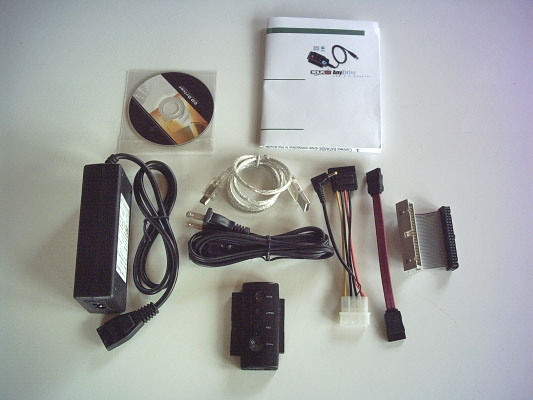
The AnyDrive kit provides you with comprehensive, multi-interface had drive connection support, and includes:
• The AnyDrive connection module, which features large, tri-color (blue, purple, red) status lights
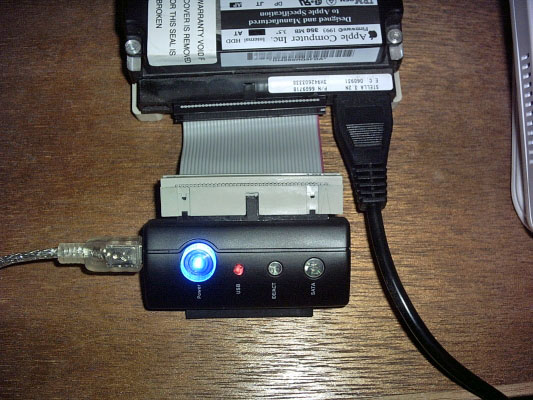
• An Power Adapter with connectors for 3.5” and 2.5” IDE drives as well as all sizes of SATA drives. The power supply is auto switching from 100v - 240v.
• An IDE flex ribbon cable connector extender for 3.5” IDE drives (necessary to clear the power supply connector on some drives)
• A USB 2.0 cable
• Plus a mini CD-ROM with Windows 98 and XP drivers that Mac users can blissfully ignore. No extra drivers are required for the Mac.
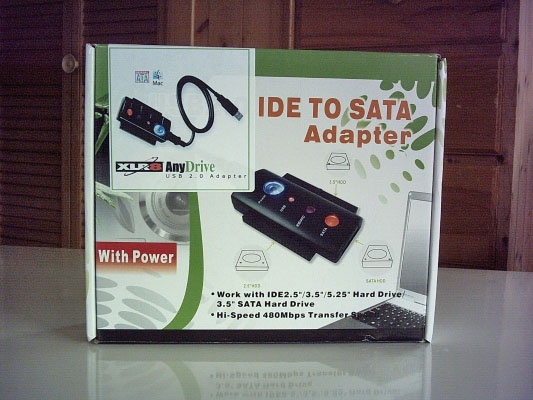
AnyDrive comes neatly packaged in a handy-sized compartment box which can continue to serve as a storage container.
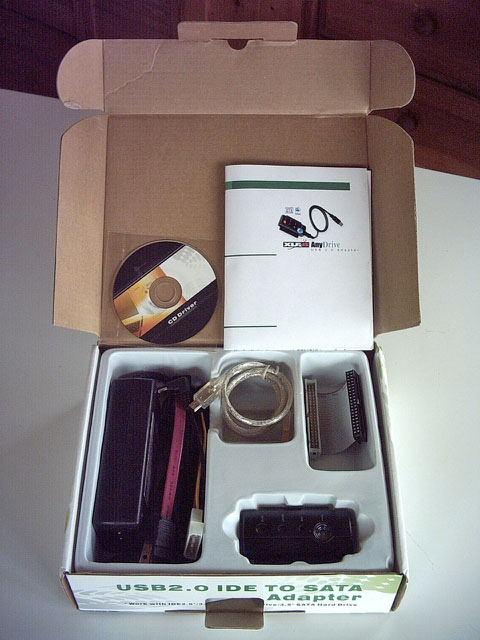
There is also a disappointingly sketchy instruction sheet, which really needs some fleshing out. I found it confusing, especially on the details of the differences in connecting various types of drives. Fortunately, it becomes fairly intuitive with a bit of eyeballing.
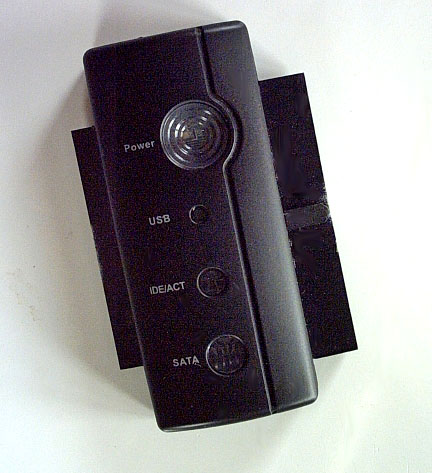
The AnyDrive module has female pin connectors on either side to accept 3.5” and 2.5” (laptop-size) IDE/ATA hard drives respectively, while SATA drives connect through a supplied adapter cable which plugs into a port on the module’s bottom.
For powering the drive, the main cable from the power adapter will plug directly into a 3.5” IDE drive, but requires the supplied ambidextrous adapter cable to make the power connection with 2.5” IDE and all SATA drives
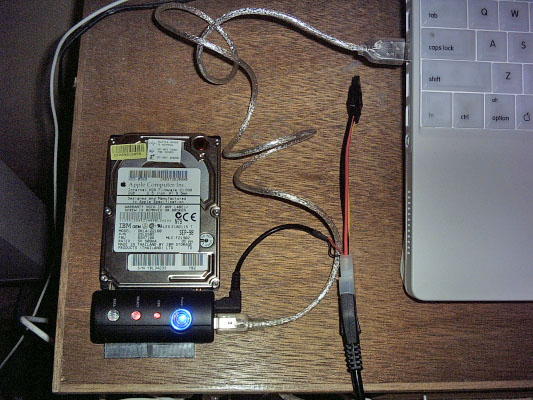
The drill goes as follows:
• Connect your drive to the AnyDrive module. As noted, I had to use the supplied ribbon cable extender to clear the power cable connector with the 3.5” IDE drive I used. With the 2.5” PowerBook drive I checked out, I was able to plug directly into the module as the power is supplied through a small jack via the adapter connector.
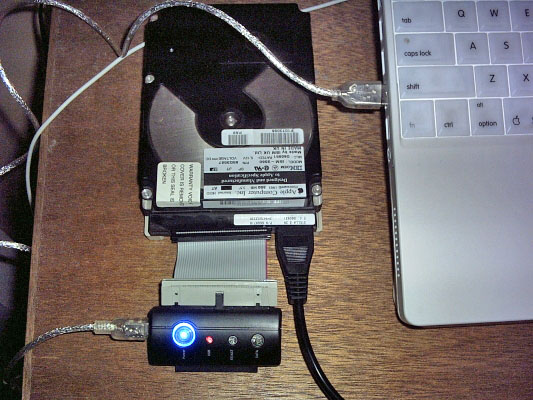
• Plug in the power adapter and the drive should power up.
• Now, just use the supplied USB cable to connect the AnyDrive module to your computer, and the hard drive should mount on your Desktop. Be sure to eject the external drive before disconnecting the AnyDrive unit.
This all worked slickly and flawlessly with the two sizes of IDE drives that I tested. I didn’t have a loose SATA drive handy to test, but I would anticipate equally satisfactory performance with one of those.
The AnyDrive adapter is an excellent and handy connectivity tool to have around, and if you want a Time Machine backup volume on the cheap, its friendly price of $24.95 plus an on-hand, scrounged or inexpensive used hard drive of whatever size and interface won’t bust your wallet. The included (some of them hard-to-find) cables, connectors, and adapters are worth the modest price alone.
However, I do have a few criticisms. I already mentioned the cryptic and confusing instruction sheet, however I mentioned this to Daystar’s Gary Dailey and he promised that the instructions would be revised, so that’s taken care of.
I’m also a bit wary of the very light diameter of the wires connecting the 2.5” IDE/ all SATA power adapter mini-jack to the cable plug. They look like they could easily fatigue or be damaged by even minor shock loads. It would also be nice if there were an inline power switch in the power adapter cable so it wouldn’t be necessary to unplug the adapter from AC current in order to power down the connected drive.
Aside from those few niggles, it’s all good.
$24.95
For more information, visit:
http://daystar-store.com/index.asp?PageAction=VIEWPROD&ProdID=795
Note: Letters to PowerBook Mystique Mailbag may or may not be published at the editor's discretion. Correspondents' email addresses will NOT be published unless the correspondent specifically requests publication. Letters may be edited for length and/or context.
Opinions expressed in postings to PowerBook Mystique MailBag are owned by the respective correspondents and not necessarily shared or endorsed by the Editor and/or PowerBook Central management.
If you would prefer that your message not appear in PowerBook Mystique Mailbag, we would still like to hear from you. Just clearly mark your message "NOT FOR PUBLICATION," and it will not be published.
CM